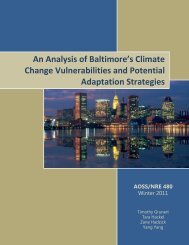Connections between simulations and observation in climate ...
Connections between simulations and observation in climate ...
Connections between simulations and observation in climate ...
Create successful ePaper yourself
Turn your PDF publications into a flip-book with our unique Google optimized e-Paper software.
H. Guillemot / Studies <strong>in</strong> History <strong>and</strong> Philosophy of Modern Physics 41 (2010) 242–252 243Météorologie Dynamique (LMD) of the CNRS, <strong>in</strong> Paris, <strong>and</strong> theCentre de Recherche de Météo-France (the French organism forweather forecast) <strong>in</strong> Toulouse. This study primarily relied on twotypes of sources: <strong>in</strong>ternal laboratory records (activity reports,plann<strong>in</strong>g reports, <strong>in</strong>ternal journals, Web sites, colloquia, workshopreports, etc.) <strong>and</strong> extensive <strong>in</strong>terviews with scientists. InSection 2 of this article, I draw a brief review of studies oncomputer model<strong>in</strong>g <strong>and</strong> <strong>climate</strong> models, <strong>and</strong> try to frame the roleof <strong>observation</strong> <strong>in</strong> validation of <strong>climate</strong> models. In Section 3, after aquick survey of the <strong>observation</strong>al data used <strong>in</strong> <strong>climate</strong> science,<strong>and</strong> an <strong>in</strong>sight of the fundamental difficulties that faces validationof <strong>climate</strong> models, I seek to describe <strong>and</strong> analyze what sorts ofrelationships modelers establish <strong>between</strong> data <strong>and</strong> model <strong>simulations</strong>,based on observ<strong>in</strong>g actual scientific practices throughseveral examples: top-down validation, local evaluation ofparametrization aga<strong>in</strong>st field experiments, validation of climaticeffects of a small scale processes, evaluation of a model’s capacityto simulate particular phenomena. . . In Section 4, I attempt toderive a few epistemological lessons on <strong>climate</strong> model<strong>in</strong>g <strong>and</strong>what dist<strong>in</strong>guishes it from more traditional theoretico-experimentalsciences <strong>in</strong> regards to their relationship to data.2. Studies on numerical models, <strong>climate</strong> model<strong>in</strong>g <strong>and</strong><strong>observation</strong>, a brief review2.1. Models <strong>between</strong> theory application <strong>and</strong> the creation ofknowledgeComputer model<strong>in</strong>g, which emerged after World War II, hass<strong>in</strong>ce the 1970s <strong>and</strong> 1980s permeated nearly all sectors of science,technology, <strong>in</strong>dustry <strong>and</strong> economy. Yet, it was only recently that itstarted elicit<strong>in</strong>g any notable research activity <strong>in</strong> philosophy,history of science or science <strong>and</strong> technology studies (STS). For along time, discourse on models privileged a ‘‘semantic’’ approachthat focused on theories <strong>and</strong> accord<strong>in</strong>g to which a model is first<strong>and</strong> foremost a representation that gives mean<strong>in</strong>g to a mathematicalformalism. Over the past few years, however, there hasbeen a renewed reflection on models. The ‘‘cult of theory’’ hasbeen criticized by authors who assert models’ superiority overtheories as representations of the world (Cartwright, 1983, 1999;Sismondo, 1999). Accord<strong>in</strong>g to Morgan <strong>and</strong> Morrison (1999),models consist of elements other than just theories <strong>and</strong> data, <strong>and</strong>‘‘it is precisely because the models are partially <strong>in</strong>dependent ofboth theories <strong>and</strong> the world that they have this autonomouscomponent <strong>and</strong> so can be used as <strong>in</strong>struments of exploration <strong>in</strong>both doma<strong>in</strong>s’’. As autonomous agents, models can therebybecome active ‘‘mediators’’ <strong>between</strong> theories <strong>and</strong> the world, <strong>and</strong>may have more to teach us than theory does on its own. Ow<strong>in</strong>g tothis mediat<strong>in</strong>g function, the model<strong>in</strong>g of complex physicalsystems—systems that are poorly understood even when theoriesof underly<strong>in</strong>g processes exist—cannot be reduced to calculationsthat apply known laws: ‘‘The computer <strong>simulations</strong> (. . .) <strong>in</strong>volvesa complex cha<strong>in</strong> of <strong>in</strong>ferences that serve to transform theoreticalstructures <strong>in</strong>to specific concrete knowledge of physical system.(. . .) This process of transformation is also a process of knowledgecreation, <strong>and</strong> it has its own unique epistemology’’ (W<strong>in</strong>sberg,1999, p. 275).Nevertheless, the cognitive approach to models <strong>in</strong> undoubtedly<strong>in</strong>sufficient. The computer’s massive <strong>in</strong>fluence, the emergenceof new scientific objects, model<strong>in</strong>g practices that are more<strong>and</strong> more heterogeneous, as well as their <strong>in</strong>creas<strong>in</strong>g use <strong>in</strong>establish<strong>in</strong>g expertise, makes ‘‘study<strong>in</strong>g the activity of model<strong>in</strong>g<strong>in</strong> its <strong>in</strong>stitutional, technical <strong>and</strong> political environment, <strong>and</strong>without dissociat<strong>in</strong>g cognitive <strong>and</strong> social elements’’ (Armatte &Dahan, 2004, p. 245) all the more necessary. Accord<strong>in</strong>g toKnuuttila et al. (2006), a convergence is already discernible<strong>between</strong> philosophers (up to this po<strong>in</strong>t focused on theories) <strong>and</strong>researchers <strong>in</strong> science studies (traditionally oriented towards thelaboratory), who are shar<strong>in</strong>g <strong>in</strong>terest <strong>in</strong> the role of model<strong>in</strong>g <strong>and</strong>simulation <strong>in</strong> scientific practices.2.2. What is at stake <strong>in</strong> study<strong>in</strong>g <strong>climate</strong> modelsUntil very recently, <strong>climate</strong> model<strong>in</strong>g attracted few epistemologists,<strong>in</strong> part because it seems to fall under application, not underfundamental physics, br<strong>in</strong>g<strong>in</strong>g <strong>in</strong>to play established physicstheories <strong>and</strong> loosely formalized heterogeneous elements. Moreover,it is embedded <strong>in</strong> expertise <strong>and</strong> embroiled <strong>in</strong> major politicalstakes. One would th<strong>in</strong>k that the latter characteristics would elicitthe <strong>in</strong>terest of the social sciences. This has been the case, but to alimited extent: the sociopolitical stakes <strong>in</strong>herent <strong>in</strong> <strong>climate</strong>models seem to have a contradictory <strong>in</strong>fluence <strong>in</strong> this regard.In the context of <strong>climate</strong> change debates, models are oftenbrought center-stage <strong>and</strong> placed <strong>in</strong>to question—how can theypurport to predict the future of <strong>climate</strong>? Political controversiesare frequently transposed to the scientific, <strong>and</strong> even epistemological,field: <strong>climate</strong> change skeptics shed doubt not only onprojections but on the models themselves <strong>and</strong> seek to ‘‘stigmatizemodel<strong>in</strong>g as <strong>in</strong>ferior science on philosophical grounds’’ (Norton &Suppe, 2001, p. 67). Much of the time, such polemics focus on therelationship <strong>between</strong> models <strong>and</strong> <strong>observation</strong>al data (Edwards,1999). Computer models are contrasted with ‘‘sounds science’’,found on data <strong>and</strong> solid theories, <strong>and</strong> the possibility of verify<strong>in</strong>gmodels’ projections aga<strong>in</strong>st data is questioned (Oreskes et al.,1994). In response to these criticisms, Paul Edwards has shownthat if models <strong>and</strong> data are effectively <strong>in</strong> a relationship of<strong>in</strong>terdependence—models be<strong>in</strong>g ‘‘data-laden’’ <strong>and</strong> data ‘‘modelfiltered’’—thisrelationship is not circular, but symbiotic, eachga<strong>in</strong><strong>in</strong>g advantage from the other. In a detailed analysis, Norton &Suppe (2001) ma<strong>in</strong>ta<strong>in</strong> that <strong>in</strong>terdependence exists <strong>between</strong>theories <strong>and</strong> experiments as well, <strong>and</strong> that the absence ofcerta<strong>in</strong>ty, simplify<strong>in</strong>g hypotheses, etc. are not the prerogative ofmodels, nor do they constitute def<strong>in</strong>itive obstacles to knowledge.These authors conclude that models may be trusted for the samereasons <strong>and</strong> to the same extent that traditional experiments areendowed with credibility or trusted.If, despite these debates, <strong>climate</strong> model<strong>in</strong>g as a new mode ofproduction of knowledge has attracted a small number of studies(comparatively to the economic or political side of the problem), itcould be that the political role of these models makes their studymore delicate, possibly risky. The research conducted <strong>in</strong> thisdoma<strong>in</strong> has shown how the representation of uncerta<strong>in</strong>ty(Shackley & Wynne, 1996), the estimate of <strong>climate</strong> sensitivity(Van der Sluijs et al., 1998), <strong>and</strong> recourse to flux adjustments(Shackley et al., 1999) all result <strong>in</strong> negotiations or <strong>in</strong> scientiststak<strong>in</strong>g <strong>in</strong>to account the expectations of policy makers. This has attimes placed researchers <strong>in</strong> an uncomfortable position: emphasiz<strong>in</strong>gthe co-construction <strong>between</strong> science <strong>and</strong> politics risksbe<strong>in</strong>g co-opted by a critique of the objectivity of <strong>climate</strong> science<strong>and</strong> the validity of its results. Even when it comes to ‘‘defend<strong>in</strong>gthe <strong>in</strong>determ<strong>in</strong>ate character of the <strong>climate</strong> sciences’’ (Shackleyet al., 1999, p. 35), any reference to uncerta<strong>in</strong>ty or ambiguity canbe turned <strong>in</strong>to a weapon <strong>in</strong> the h<strong>and</strong>s of critics of the fight aga<strong>in</strong>stglobal warm<strong>in</strong>g (Edwards, 1996). Forsyth (2003, p. xiii) analyzedit well when he wrote: ‘‘these are controversial times for writ<strong>in</strong>gabout environmental science <strong>and</strong> politics’’. The political stakescan lead to clos<strong>in</strong>g black boxes more so than to analyz<strong>in</strong>g theircontent; to prematurely transform<strong>in</strong>g ‘‘matters of concern’’ <strong>in</strong>to‘‘matters of fact’’ (Latour, 2004).




